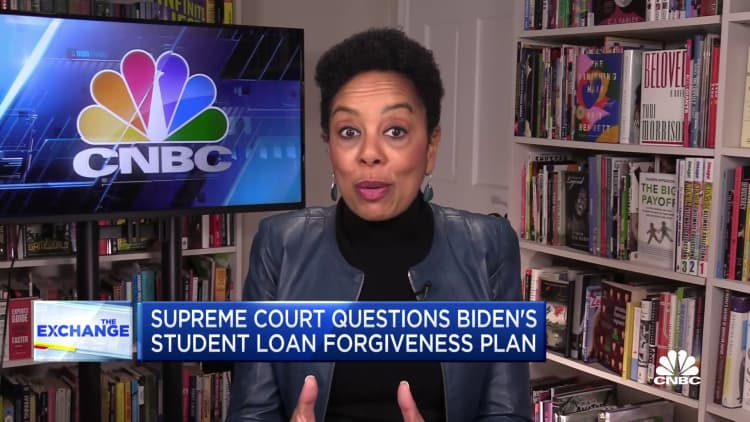Viktorcvetkovic | Istock | Getty Images
Over the three-year-long pause on student loan payments, the U.S. Department of Education has repeatedly told borrowers their bills were set to resume, only to take it back and provide them more time.
This time, however, the agency really means it.
The Education Department posted on its website that “payments will be due starting in October,” and a recent law passed by Congress will make changing that plan difficult.
It will likely be a big adjustment for borrowers when the pandemic-era policy expires. Around 40 million Americans have debt from their education. The typical monthly bill is roughly $350.
“For many borrowers, the payment pause has been life altering — saving many from financial ruin and allowing others to finally get ahead financially,” said Persis Yu, deputy executive director at the Student Borrower Protection Center.
Here’s what to know.
3-year pause saved the average borrower $15,000
Former President Donald Trump first announced the stay on federal student loan bills and the accrual of interest in March 2020, when the coronavirus pandemic hit the U.S. and crippled the economy.
The pause has since been extended eight times.
Nearly all people eligible for the relief have taken advantage of it, with less than 1% of qualifying borrowers continuing to make payments on their education debt, according to an analysis by higher education expert Mark Kantrowitz.
As a result of the policy, the average borrower likely saved around $15,000 in student loan payments, Kantrowitz said.
Why the pause will end in the fall
The Education Department notes on its financial aid website that “Congress recently passed a law preventing further extensions of the payment pause.”
It is referring to the agreement reached between Republicans and Democrats to raise the nation’s debt ceiling, which President Joe Biden signed into law in early June.
In exchange for voting to increase the borrowing limit, Republicans demanded large cuts to federal spending. They sought to repeal Biden’s executive action granting student loan forgiveness, but the Biden administration refused to agree to that.
However, included in the deal was a provision that officially terminates the pause at the end of August.
More from Personal Finance:
Popular home improvements aren’t the ones with best return
Debt deal would push student loan borrowers to repay this fall
Many companies adding, expanding tuition assistance
Even before that agreement, the Biden administration had been preparing borrowers for their payments to resume by September.
“The emergency period is over, and we’re preparing our borrowers to restart,” Education Secretary Miguel Cardona recently said at a Senate hearing.
Interest will pick up in September, payments in October
The Education Department says borrowers will be expected to make their first post-pause payment in October. Meanwhile, interest will start accumulating on borrowers’ debt again on Sept. 1, the department says.
Exact due dates will vary based on your account details, Kantrowitz said.
“Your due date will be at least 21 days after you’re sent a loan statement,” he said.
Borrowers don’t know what they’ll owe
As the Biden administration tries to ready millions of Americans to restart their student loan payments, there’s one big open question that may make that preparation difficult: Most borrowers don’t know what they’ll owe in the fall.
That’s because the Supreme Court has yet to issue a verdict on the validity of Biden’s plan to cancel up to $20,000 in student debt for borrowers. A decision is expected this month.
Around 37 million people would be eligible for some loan cancellation, Kantrowitz estimated.
Roughly a third of those with federal student loans, or 14 million people, would have their balances entirely forgiven by the president’s program, according to an estimate by Kantrowitz. As a result, these borrowers won’t owe anything come October.
For those who still have a balance after the relief, the Education Department has said it plans to “re-amortize” borrowers’ lower debts. That’s a wonky term that means it will recalculate people’s monthly payment based on their lower tab and the number of months they have left on their repayment timeline.
Kantrowitz provided an example: Let’s say a person currently owes $30,000 in student loans at a 5% interest rate.
Before the pandemic, they would have paid around $320 a month on a 10-year repayment term. If forgiveness goes through and that person gets $10,000 in relief, their total balance would be reduced by a third, and their monthly payment will drop by a third, to roughly $210 a month.

Education Department Undersecretary James Kvaal recently warned that if the administration is unable to deliver on Biden’s loan forgiveness, delinquency and default rates could skyrocket.
The borrowers most in jeopardy of defaulting are those for whom Biden’s policy would have wiped out their balance entirely, Kvaal said.
“Unless the Department is allowed to provide one-time student loan debt relief,” Kvaal said, “we expect this group of borrowers to have higher loan default rates due to the ongoing confusion about what they owe.”







